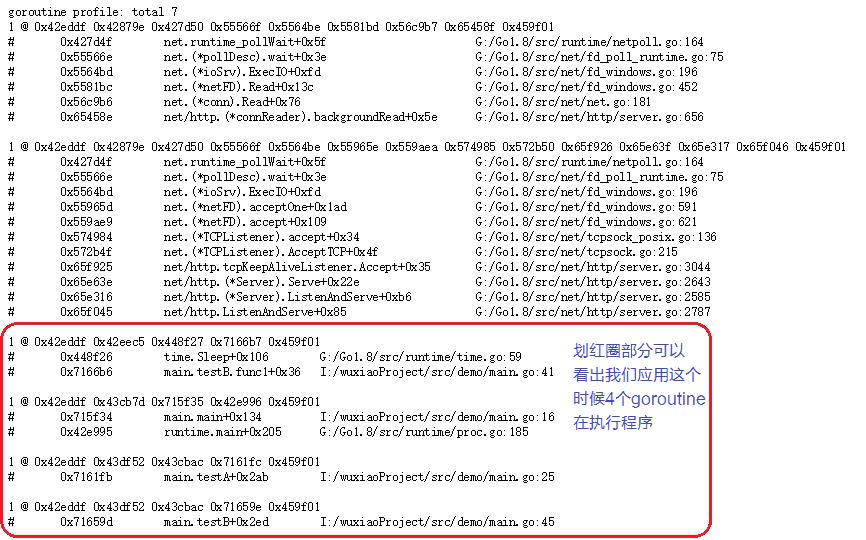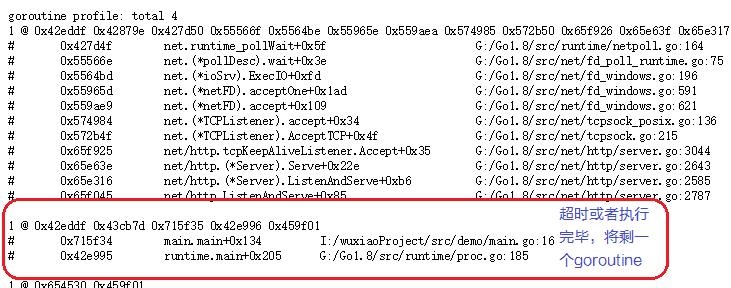一日一学_Go语言Context(设计及分析)
Posted Golang语言社区
tags:
篇首语:本文由小常识网(cha138.com)小编为大家整理,主要介绍了一日一学_Go语言Context(设计及分析)相关的知识,希望对你有一定的参考价值。
文 | WuXiao_
共 9497 字,阅读需 24 分钟
context简单概述:
Go服务器的每个请求都有自己的goroutine,而有的请求为了提高性能,会经常启动额外的goroutine处理请求,当该请求被取消或超时,该请求上的所有goroutines应该退出,防止资源泄露。那么context来了,它对该请求上的所有goroutines进行约束,然后进行取消信号,超时等操作。

而context优点就是简洁的管理goroutines的生命周期。
context简单使用:
接下来模拟一个超时继续分析context
注意: 使用时遵循context规则
1. 不要将 Context放入结构体,Context应该作为第一个参数传入,命名为ctx。
2. 即使函数允许,也不要传入nil的 Context。如果不知道用哪种Context,可以使用context.TODO()。
3. 使用context的Value相关方法,只应该用于在程序和接口中传递和请求相关数据,不能用它来传递一些可选的参数
4. 相同的 Context 可以传递给在不同的goroutine;Context 是并发安全的。使用net/http/pprof对goroutines进行查看:

package main
import (
"context"
"fmt"
"net/http"
_ "net/http/pprof"
"time"
)
func main() {
go http.ListenAndServe(":8080", nil)
ctx, _ := context.WithTimeout(context.Background(), (10 * time.Second))
go testA(ctx)
select {}
}
func testA(ctx context.Context) {
ctxA, _ := context.WithTimeout(ctx, (5 * time.Second))
ch := make(chan int)
go testB(ctxA, ch)
select {
case <-ctx.Done():
fmt.Println("testA Done")
return
case i := <-ch:
fmt.Println(i)
}
}
func testB(ctx context.Context, ch chan int) {
//模拟读取数据
sumCh := make(chan int)
go func(sumCh chan int) {
sum := 10
time.Sleep(10 * time.Second)
sumCh <- sum
}(sumCh)
select {
case <-ctx.Done():
fmt.Println("testB Done")
<-sumCh
return
//case ch <- <-sumCh: 注意这样会导致资源泄露
case i := <-sumCh:
fmt.Println("send", i)
ch <- i
}
}
模拟数据库读取效率慢
从执行中和执行后的结果来看,我们完美的关闭了不需要的goroutine,

超时
概述中提到:
当应用场景是由一个请求衍生出多个goroutine完成需求,那它们之间就需要满足一定的约束关系,才能中止routine树,超时等操作。
那么是如何到达约束关系?
简单理解,Context 的调用以链式存在,通过WithXxx方法派生出新的 Context与当前父Context 关联,当父 Context 被取消时,其派生的所有 Context 都将取消。

WithCancel派生约束关系图
上图WithCancel派生简单分析图,接下里我们进行源码分析,进一步了解Context的约束关系(WithXxx方法派生大概与WithCancel相同)。
Context源码分析:
type Context interface {
Deadline() (deadline time.Time, ok bool)
Done() <-chan struct{}
Err() error
Value(key interface{}) interface{}
}Deadline() 返回的time.Time 它为Context 的结束的时间,ok 表示是否有 deadline Done() 返回一个信道,当对Context进行撤销或过期时,该信道就会关闭的,可以简单认为它是关闭信号。
Err() 当Done信道关闭后,Err会返回关闭的原因(如超时,手动关闭)
Value(key interface{}) 一个 K-V 存储的方法
canceler提供了cancal函数,同时要求数据结构实现Context
type canceler interface {
cancel(removeFromParent bool, err error)
Done() <-chan struct{}
}//默认错误
var Canceled = errors.New("context canceled")
var DeadlineExceeded = errors.New("context deadline exceeded")实现Context的数据结构
type emptyCtx int
func (*emptyCtx) Deadline() (deadline time.Time, ok bool) {
return
}
func (*emptyCtx) Done() <-chan struct{} {
return nil
}
func (*emptyCtx) Err() error {
return nil
}
func (*emptyCtx) Value(key interface{}) interface{} {
return nil
}
func (e *emptyCtx) String() string {
switch e {
case background:
return "context.Background"
case todo:
return "context.TODO"
}
return "unknown empty Context"
}两个实现Context的空结构。
var (
background = new(emptyCtx)
todo = new(emptyCtx)
)
func Background() Context {
return background
}
func TODO() Context {
return todo
}cancelCtx结构体继承了Context,同时实现了canceler接口:
type cancelCtx struct {
Context
done chan struct{} // closed by the first cancel call.
mu sync.Mutex
children map[canceler]bool // set to nil by the first cancel call
err error // 当被cancel时将会把err设置为非nil
}
func (c *cancelCtx) Done() <-chan struct{} {
return c.done
}
func (c *cancelCtx) Err() error {
c.mu.Lock()
defer c.mu.Unlock()
return c.err
}
func (c *cancelCtx) String() string {
return fmt.Sprintf("%v.WithCancel", c.Context)
}
func (c *cancelCtx) cancel(removeFromParent bool, err error) {
if err == nil {
panic("context: internal error: missing cancel error")
}
c.mu.Lock()
//timerCtx会频繁使用这块代码,因为派生出来
//timerCtx全部指向同一个cancelCtx.
if c.err != nil {
c.mu.Unlock()
return // already canceled
}
c.err = err
//关闭c.done
close(c.done)
//依次遍历c.children,每个child分别cancel
for child := range c.children {
// NOTE: acquiring the child's lock while holding parent's lock.
child.cancel(false, err)
}
c.children = nil
c.mu.Unlock()
//如果removeFromParent为true,则将c从其parent的children中删除
if removeFromParent {
removeChild(c.Context, c)
}
}
//如果parent为valueCtx类型,将循环找最近parent
//为CancelCtx类型的,找到就从父对象的children
//map 中删除这个child,否则返回nil(context.Background或者 context.TODO)
func removeChild(parent Context, child canceler) {
p, ok := parentCancelCtx(parent)
if !ok {
return
}
p.mu.Lock()
if p.children != nil {
delete(p.children, child)
}
p.mu.Unlock()
}接下来分析Cancel相关代码
type CancelFunc func()
//WithCancel方法返回一个继承parent的Context对
//象,同时返回的cancel方法可以用来关闭当前
//Context中的Done channel
func WithCancel(parent Context) (ctx Context, cancel CancelFunc) {
c := newCancelCtx(parent)
propagateCancel(parent, &c)
return &c, func() { c.cancel(true, Canceled) }
}
func newCancelCtx(parent Context) cancelCtx {
return cancelCtx{
Context: parent,
done: make(chan struct{}),
}
}
func propagateCancel(parent Context, child canceler) {
if parent.Done() == nil {
return // parent is never canceled
}
if p, ok := parentCancelCtx(parent); ok {
p.mu.Lock()
if p.err != nil {
//如果找到的parent已经被cancel,
//则将方才传入的child树给cancel掉
child.cancel(false, p.err)
} else {
//否则, 将child节点直接添加到parent的children中
//(这样就有了约束关系,向上的父亲指针不变
//,向下的孩子指针可以直接使用 )
if p.children == nil {
p.children = make(map[canceler]bool)
}
p.children[child] = struct{}{}
}
p.mu.Unlock()
} else {
//如果没有找到最近的可以被cancel的parent,
//则启动一个goroutine,等待传入的parent终止,
//并cancel传入的child树,或者等待传入的child终结。
go func() {
select {
case <-parent.Done():
child.cancel(false, parent.Err())
case <-child.Done():
}
}()
}
}
//判断parent是否为cancelCtx类型
func parentCancelCtx(parent Context) (*cancelCtx, bool) {
for {
switch c := parent.(type) {
case *cancelCtx:
return c, true
case *timerCtx:
return &c.cancelCtx, true
case *valueCtx:
parent = c.Context
default:
return nil, false
}
}
}timerCtx 继承cancelCtx的结构体,这种设计就可以避免写重复代码,提高复用
type timerCtx struct {
cancelCtx
timer *time.Timer // Under cancelCtx.mu. 计时器
deadline time.Time
}
func (c *timerCtx) Deadline() (deadline time.Time, ok bool) {
return c.deadline, true
}
func (c *timerCtx) String() string {
return fmt.Sprintf("%v.WithDeadline(%s [%s])", c.cancelCtx.Context, c.deadline, c.deadline.Sub(time.Now()))
}
// 与cencelCtx有所不同,除了处理cancelCtx.cancel,
// 还回对c.timer进行Stop(),并将c.timer=nil
func (c *timerCtx) cancel(removeFromParent bool, err error) {
c.cancelCtx.cancel(false, err)
if removeFromParent {
// Remove this timerCtx from its parent cancelCtx's children.
removeChild(c.cancelCtx.Context, c)
}
c.mu.Lock()
if c.timer != nil {
c.timer.Stop()
c.timer = nil
}
c.mu.Unlock()
}timerCtx具体的两个方法:
func WithDeadline(parent Context, deadline time.Time) (Context, CancelFunc) {
//如果parent的deadline比新传入的deadline早,则直接
//返回WithCancel,因为parent的deadline会先失效,而新的
//deadline根据不需要
if cur, ok := parent.Deadline(); ok && cur.Before(deadline) {
// The current deadline is already sooner than the new one.
return WithCancel(parent)
}
c := &timerCtx{
cancelCtx: newCancelCtx(parent),
deadline: deadline,
}
propagateCancel(parent, c)
//检查如果已经过期,则cancel新child树
d := deadline.Sub(time.Now())
if d <= 0 {
c.cancel(true, DeadlineExceeded) // deadline has already passed
return c, func() { c.cancel(true, Canceled) }
}
c.mu.Lock()
defer c.mu.Unlock()
if c.err == nil {
//没有被cancel的话,就设置deadline之后cancel的计时器
c.timer = time.AfterFunc(d, func() {
c.cancel(true, DeadlineExceeded)
})
}
return c, func() { c.cancel(true, Canceled) }
}
// WithTimeout简单暴力,直接把WithTimeout返回
func WithTimeout(parent Context, timeout time.Duration) (Context, CancelFunc) {
return WithDeadline(parent, time.Now().Add(timeout))
}valueCtx主要用来传递一些可比较操作的数据
func WithValue(parent Context, key, val interface{}) Context {
if key == nil {
panic("nil key")
}
if !reflect.TypeOf(key).Comparable() {
panic("key is not comparable")
}
return &valueCtx{parent, key, val}
type valueCtx struct {
Context
key, val interface{}
}
func (c *valueCtx) String() string {
return fmt.Sprintf("%v.WithValue(%#v, %#v)", c.Context, c.key, c.val)
}
func (c *valueCtx) Value(key interface{}) interface{} {
if c.key == key {
return c.val
}
return c.Context.Value(key)
}
总结完了,如果哪里不足,请大家提出问题一起学习,谢谢!
以上是关于一日一学_Go语言Context(设计及分析)的主要内容,如果未能解决你的问题,请参考以下文章
2022-10-16:以下go语言代码输出什么?A:timed out;B:panic;C:没有任何输出。 package main import ( “context“ “fmt“
GoLand:Go编码开发工具|Go语言编码协助人体工学设计快速导航代码生成
2022-07-20:以下go语言代码是关于json 和 context的,输出什么?A:{};B:{“a“:“b“};C:{“Context“:0};D:不确定。 package main imp